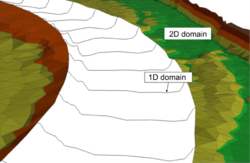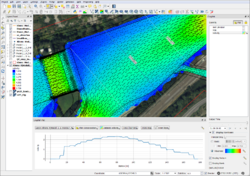BASEMENT
Contents
Quick summary
Developed by: Laboratory of hydraulics, hydrology and glaciology (VAW) of ETH Zurich
Date: May 2018 (Version 2.8)
Type: Tool
Introduction
BASEMENT (BAsic Simulation EnvironMENT) is a numerical software for the simulation of hydro- and morphodynamics in rivers. The main motivation for the development of the software is to provide a powerful user-friendly tool that facilitates basic applications for practitioners as well as advanced model configurations for research. The underlying one- and two-dimensional models are based on the Saint-Venant equations for the hydrodynamics, the Exner-Hirano equations for bed load transport and an advection-diffusion approach with source terms for suspended sediment transport. Mentionable special features of the software are arbitrary combinations of 1D and 2D model domains (Figure 1), a PID controller for various monitoring values and the use of an unstructured dual-mesh to improve topographic accuracy.
Application
The 1D model of BASEMENT is based on river cross sections and its main application are river reaches where the level of detail is less important. The 2D model uses a triangular computational grid to reproduce the topography and can be applied to more detailed and complex problems than the 1D model, e.g. the inundation or river bar formation. BASEMENT supports Windows as well as Linux platforms and includes a graphical user interface (GUI) which supports the user during the model setup and simulation process (Figure 2). For grid generation, the QGIS plugin BASEmesh is provided by the developers and for visualization of the results, among others, the QGIS plugin Crayfish (QGIS 2.8) from Lutra Consulting (https://www.lutraconsulting.co.uk) can be used (Figure 3).
Relevant mitigation measures and test cases
Other information
In addition to the use on regular Windows and Linux workstations, the upcoming version 3.0 of BASEMENT (March 2019) is designed to run on graphical processing units (GPUs) and distributed memory computer clusters allowing engineers to tackle problems with very large computational domains or long simulation time.
Relevant literature
- Vetsch D., Siviglia A., Caponi F., Ehrbar D., Gerke E., Kammerer S., Koch A., Peter S., Vanzo D., Vonwiller L., Facchini M., Gerber M., Volz C., Farshi D., Mueller R., Rousselot P., Veprek R., Faeh R. 2018. System Manuals of BASEMENT, Version 2.8. Laboratory of Hydraulics, Glaciology and Hydrology (VAW). ETH Zurich. Available from http://www.basement.ethz.ch.
Contact information
Website (download, tutorials, etc.): http://www.basement.ethz.ch
Email: basement@ethz.ch



